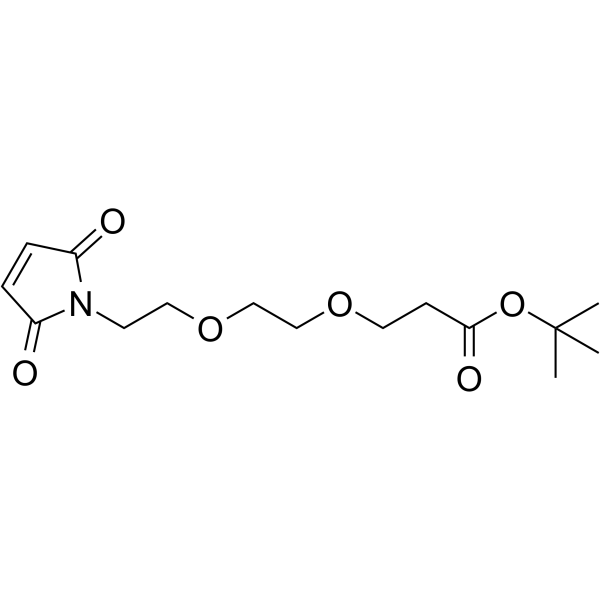
Mal-PEG2-C2-Boc
CAS No. 1374666-31-5
Mal-PEG2-C2-Boc( Mal-PEG2-T-Butyl Ester )
Catalog No. M26980 CAS No. 1374666-31-5
Mal-PEG2-C2-Boc is a PEG-based PROTAC linker that can be used in the synthesis of PROTACs.
Purity : >98% (HPLC)
 COA
COA
 Datasheet
Datasheet
 HNMR
HNMR
 HPLC
HPLC
 MSDS
MSDS
 Handing Instructions
Handing Instructions
| Size | Price / USD | Stock | Quantity |
| 25MG | 50 | Get Quote |


|
| 50MG | 68 | Get Quote |


|
| 100MG | 88 | Get Quote |


|
| 200MG | Get Quote | Get Quote |


|
| 500MG | Get Quote | Get Quote |


|
| 1G | Get Quote | Get Quote |


|
Biological Information
-
Product NameMal-PEG2-C2-Boc
-
NoteResearch use only, not for human use.
-
Brief DescriptionMal-PEG2-C2-Boc is a PEG-based PROTAC linker that can be used in the synthesis of PROTACs.
-
DescriptionMal-PEG2-C2-Boc is a PEG-based PROTAC linker that can be used in the synthesis of PROTACs.(In Vitro):PROTACs contain two different ligands connected by a linker; one is a ligand for an E3 ubiquitin ligase and the other is for the target protein. PROTACs exploit the intracellular ubiquitin-proteasome system to selectively degrade target proteins.
-
In VitroPROTACs contain two different ligands connected by a linker; one is a ligand for an E3 ubiquitin ligase and the other is for the target protein. PROTACs exploit the intracellular ubiquitin-proteasome system to selectively degrade target proteins.
-
In Vivo——
-
SynonymsMal-PEG2-T-Butyl Ester
-
PathwayOthers
-
TargetOther Targets
-
RecptorFungal
-
Research Area——
-
Indication——
Chemical Information
-
CAS Number1374666-31-5
-
Formula Weight313.35
-
Molecular FormulaC15H23NO6
-
Purity>98% (HPLC)
-
Solubility——
-
SMILESCC(C)(C)OC(=O)CCOCCOCCN1C(=O)C=CC1=O
-
Chemical Name——
Shipping & Storage Information
-
Storage(-20℃)
-
ShippingWith Ice Pack
-
Stability≥ 2 years
Reference
1.Zhao H, et al. Dissipation and residue of fenpropidin in wheat and soil under field conditions. Ecotoxicol Environ Saf. 2012 Mar;77:52-6.
molnova catalog



related products
-
Hydrocinnamic acid
Phenylpropanoic acid or hydrocinnamic acid is a carboxylic acid belonging to the class of phenylpropanoids.
-
Reactive Blue 4
Reactive Blue 4 is an anthraquinone dye with phytotoxic, cytotoxic, and genotoxic.
-
Mitoquinol mesylate
Mitoquinol, a ubiquinone derivative, specifically accumulates in mitochondria due to the covalent attachment of the cation triphenylphosphonium.



 Cart
Cart
 sales@molnova.com
sales@molnova.com


